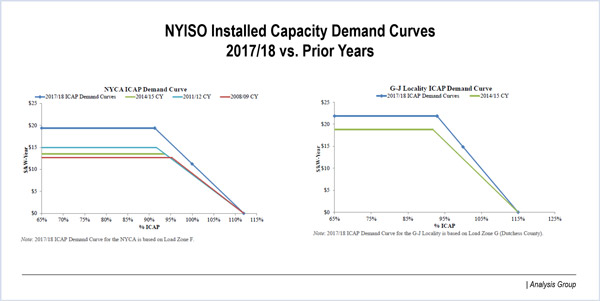By Rich Heidorn Jr.
FERC last week approved NYISO’s revised demand curves but said the ISO must eliminate the assumption that new peaking plants in the New York Control Area (NYCA) will require emissions controls (ER17-386).
The Jan. 17 order approved NYISO’s Nov. 18 proposal on all but one of nine contested issues. The new demand curves will take effect with the ISO’s capacity auction for the 2017/18 capability year beginning May 1 and will be the basis for auctions through the 2020/21 delivery year. (See IPPNY: Demand Curve Reset ‘Top Priority’.)
The ISO will continue to use the F class frame peaking turbine as the proxy unit for setting the cost of new entry. It also continued the requirement that peaking plants include dual-fuel capability and selective catalytic reduction (SCR) emissions controls for the New York City, Long Island and G-J Locality demand curves.
But the commission rejected the ISO’s proposal to extend the SCR requirement to the NYCA, where gas-only designs were permitted.
The curves, calculated for NYISO by consulting firm Analysis Group, suggest increased prices in most zones, with Zones G-J starting at about $22/kW-year, up from less than $20 for 2014/15. Long Island’s curve starts at almost $25, versus about $21 in the previous curve. The New York City curve is virtually unchanged with a $26 starting point.
The NYCA curve would have jumped from a starting point of about $14 to almost $20.
In its last demand curve reset, the ISO proposed that the NYCA peaking plant operate under an annual operating hours limit in lieu of installing SCR emissions controls. FERC said that assumption still holds, despite the ISO’s contention that peakers without the controls risk not obtaining necessary air permits.
“It is undisputed that SCR emissions controls are not required for peaking plants located in load zones C and F in NYCA,” the commission said. “In addition, NYISO admits that the F class frame turbine can meet the New Source Performance Standard requirement to limit nitrogen oxides emissions while operating on natural gas without SCR emissions controls.”
The ISO acknowledged that F class turbines can meet New Source Performance Standards for carbon dioxide emissions without SCR controls by limiting their operations to 3,300 hours annually, a capacity factor limit of 38%.
The Independent Power Producers of New York joined the ISO in calling for the SCR inclusion, contending that increasing concern in New York over fossil fuels will pressure the state’s Siting Board to require tougher controls.
FERC said their position was “speculative,” quoting from its order in the last reset that “while there is always a risk that regulations will change in the future, we cannot base the finding of viability on speculation that the EPA or New York state regulators will act at some point in the future.”
It noted that the demand curve reset process takes place every four years “so that changed circumstances, such as new regulations, can be taken into account.”
“We find more compelling the statements from [the New York State Department of Environmental Conservation] and evidence that New York state has issued air permits and Article 10 certificates for electric generators without SCR emissions controls in recent years. Specifically, NYSDEC stated in its comments to the NYISO Board of Directors that its permit reviews are fact specific, so SCR emissions controls to limit nitrogen oxides emissions “may not be required or appropriate in every case, such as where other control measures are available or where a facility accepts federally enforceable permit conditions to limit emissions below the applicable thresholds.
“We are more persuaded by NYSDEC’s comments and N.Y. Siting Board precedent than speculation about future public involvement in [plant] certification proceedings,” the commission said.
The commission ordered the ISO to file a revised Tariff within 30 days removing the SCR requirement for NYCA.
FERC otherwise approved the ISO’s filing as is, siding with it on the choice of the F class turbine, peaking plant costs, property tax treatment, natural gas forecasts, and incorporation of shortage pricing into the net energy and ancillary services revenues assumptions.
The auction for the 2017 summer capability period (May 1- Oct. 31) will be conducted March 30-31, with results posted April 4.





